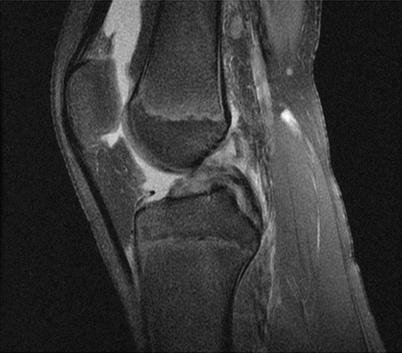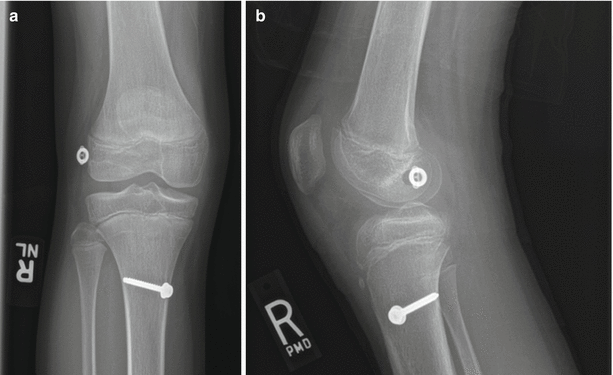Fig. 13.1
A drawing of a physeal sparing, combined intra-articular and extra-articular ACL reconstruction
An essential component of treating an ACL injury in this population is developing a comfort in assessing the maturity of the young athlete [18]. This can help the physician determine how respectful to be of the growth plates around the knee when planning surgical reconstruction and discussing options. Recognizing the common discordance between chronological age and skeletal age is the first step in surgical planning [18]. Skeletal growth is usually complete by 14 in girls and 16 in boys, though significant variation does exist. The physiologic age of the patient can be assessed by a number of techniques. Commonly used methods in an orthopedic clinic are [4]:
- (1)
Bone age by left hand radiograph (Greulich and Pyle Atlas)
- (2)
Knee radiographs
- (3)
Menarchal status in female patients
Tanner staging is often cited as a predictive method, though this presents practical challenges in the typical environment of an orthopedic practice. It should be noted that patient or parent reported Tanner staging is an inadequate substitute for the originally described physician assessment [19].
At our institution, we recommend an abridged short hand version of the Greulich and Pyle to help with bone age without use of an atlas (See Tables 13.1, 13.2 and 13.3).
Table 13.1
The hospital for sick children cheat sheet for Greulich and Pyle
Girls | Boys | Hand radiographic finding |
|---|---|---|
11.5 | 13 | Can see thumb sesamoid |
12 | 14 | Distal phalanx growth plate fused |
13 | 15 | Middle phalanx growth plate fused |
14 | 16 | Proximal phalanx growth plate fused |
Table 13.2
Review of literature on surgical outcomes following pediatric ACL reconstructiona
Technique | Studies | Number | Mean age (y) | Mean F/u (months) | Graft | Re-injury rate |
|---|---|---|---|---|---|---|
Extraphyseal | Bonnard [43] | 56 | 12.2 | 66 | BTB | 5.4 % |
Physeal sparing | Kocher [13] | 44 | 10.3 | 64 | ITB | 2/44 |
Nakhostine [44] | 5 | 14.0 | 24 | Fascia Lata | 0 | |
Parker [45] | 6 | 13.3 | 33. | Hamstring | NR | |
All-epiphyseal | Cordasco [46] | 23 | 11.8 | 24 | Hamstring | 4.3 % |
Hui [27] | 16 | 12 | 24 | Hamstring | NR | |
Anderson [47] | 12 | 13.3 | 49 | Hamstring | NR | |
Guzzanti [48] | 8 | 11.2 | 69 | Hamstring | NR | |
Partial transphyseal and hybrid | Emory Group [24] | NR | NR | NR | Hamstring | NR |
Lo [25] | 5 | 12.9 | 89 | Hamstring | NR | |
Andrews [49] | 13.5 | 58 | Achilles allograft/Fascia Lata | NR | ||
Transphyseal | Redler [10] | 16 | 14.2 | 43 | Hamstring | 0 |
Courvoisier [50] | 37 | 14 | 36 | Hamstring | 8.1 % | |
Cohen [26] | 26 | 13.3 | 45 | Hamstring | 6.7 % | |
Liddle [28] | 17 | 12 | 44 | Hamstring | 5.9 % | |
Kocher [5] | 59 | 14.7 | 43 | Hamstring | NR | |
McIntosh [51] | 16 | 13.5 | 41 | Hamstring | 12.5 % | |
Aronowitz [29] | 15 | 14 | 25 | Achilles Allograft | NR | |
Lipscomb [52] | 24 | 15 | 35 | Hamstring | NR |
Table 13.3
Levels of evidence for ACL injuries in the developing athlete
Statement | Grade of recommendation | References |
|---|---|---|
Untreated ACL injuries lead to meniscal tears and chondral damage | B | |
Prevention programs can reduce ACL injuries | B | |
Physeal Sparing reconstructions can restore stability to the developing knee | C | |
Hybrid reconstruction techniques can restore knee stability with minimal risk of significant physeal arrest | C | |
Transphyseal reconstruction can provide knee stability but some risk for physeal injury and should be reserved for children near the end of growth | C |
Treatment Options
What is required in these athletes is an approach to the ACL reconstruction that addresses the concern of iatrogenic injury and respects the physics, but without fearing it.
Non-operative
This approach does not lead to good results in the setting of a complete ACL rupture, unless the child is compliant with significant activity modification and abstinence from cutting and pivoting sports and activities. There is a very high rate of sport drop out [14] as well as rates of chondral and meniscal injuries. Developing athletes with partial ACL tears involving less than 50 % of the entire diameter with a clinically stable knee on examination may successfully be treated non-surgically [3, 20]. The athlete in this clinical scenario can return to sport in 6 months after the injury after a period of activity modification, therapy and bracing [3].
Operative
Iliotibial Band Reconstruction
A combined intra-articular and extra-articular reconstruction developed by MacIntosh and Darby in Toronto [21] and popularized in skeletally immature patients by Kocher and Micheli at Boston Children’s [13]. The technique provides knee stability and avoids complications related to growth disturbance because there are no drill holes or tunnels (Fig. 13.2). This technique is primarily recommended for use in the prepubescent patient. To be successful, the harvest requires a length of 20 cm from the central one third of the iliotibial band. The graft is left attached to Gerdy’s tubercle distally, brought into the knee in the over-the-top position and then brought under the intrameniscal ligament. The femoral side is secured by sewing the graft to the intermuscular septum and periosteum on the femur and the tibial side is secured by sewing down the graft in a trough of periosteum [1, 21].


Fig. 13.2
Torn ACL Sagittal T2 image 12 year old male
The Level IV results of 44 children that underwent this surgery (mean age 10.3 with 5.3 years of follow up) demonstrated no growth disturbance [13]. Forty-one patients had normal or near normal Lachman examinations and 31 of 44 had no pivot shift. Subjective knee score using Lysholm was 95.7 and IKDC was 96.7. The failure rate was only 4.5 % (2 patients).
All-Epiphyseal
There are now a few different techniques that are physeal sparing and have tunnels only in the epiphysis of the femur and tibia. The Anderson technique is a freehand, two incision technique that uses quadrupled hamstring graft with a suspensory fixation on the femur and secures the tibial side by tying down on a screw and washer as the post. The mean age was 13.3 and with over 4 years of follow up the knee scores are excellent with IKDC of 96 and no reported cases of growth disturbances [13] (Figs 13.3 a and b).









